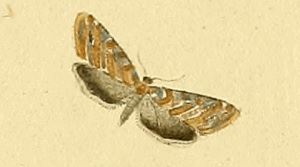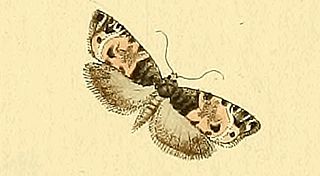
The Cochylini are a tribe of tortrix moths. It used to be classified as the subfamily Cochylinae.

Eupoecilia ambiguella, the vine moth, is a moth of the family Tortricidae. It is found in Europe, China, India, Japan, Korea, Mongolia and the Russian Far East.

Eupoecilia is a genus of moths belonging to the subfamily Tortricinae of the family Tortricidae. It was described by Stephens in 1829.

Phalonidia contractana is a moth of the family Tortricidae. It is found in southern Europe, Dalmatia, Macedonia, Hungary, Romania, Bulgaria, Greece, Ukraine, southern Russia (Sarepta), Uralsk, Turkey, Kuldscha, Afghanistan, Kashmir, Lebanon, China, Iran, Pakistan and Kyrgyzstan.

Notocelia cynosbatella is a moth of the family Tortricidae. It is found from Europe to eastern Russia, it is also found in Asia Minor, Iran, Kazakhstan, China and Mongolia.
Zeiraphera rufimitrana, the red-headed fir tortricid, is a moth of the family Tortricidae. It is found from central Europe to eastern Russia, Mongolia, the Korean Peninsula, China and Japan. It was first recorded from the Netherlands by Kuchlein and Naves in 1999.

Eupoecilia angustana is a moth of the family Tortricidae. It is found in most of Europe to the southern part of the Urals, and across the Palearctic to China, Japan and Korea.

Cochylidia moguntiana is a species of moth of the family Tortricidae. It is found in Spain, Sweden, Denmark, Germany, Poland, Austria, Italy, the Czech Republic, Slovakia, Croatia, Hungary, Romania, Estonia, Latvia, Lithuania, Russia, Afghanistan, Kyrgyzstan, northern Pakistan, Iran, China and Korea.
Eupoecilia aburica is a species of moth of the family Tortricidae. It was described by Józef Razowski in 1993, and is found in Ghana.
Eupoecilia kruegeriana is a species of moth of the family Tortricidae. It is found in South Africa, Kenya, Tanzania and Uganda. The habitat consists of various shrub and forest areas, Acacia woodland and the edges of rain forests.
Eupoecilia amphimnesta is a species of moth of the family Tortricidae. It is found in China, Taiwan, India, Japan, Korea, Mongolia, Russia and Europe.
Eupoecilia citrinana is a species of moth of the family Tortricidae. It is found in China, Japan, Korea and Russia.
Eupoecilia inouei is a species of moth of the family Tortricidae. It is found in China, Japan, Korea and Russia.
Eupoecilia kobeana is a species of moth of the family Tortricidae. It is found in China, Taiwan, Japan, Korea and Russia.
Eupoecilia quinaspinalis is a species of moth of the family Tortricidae. It is found in China.

Eupoecilia cebrana is a species of moth of the family Tortricidae. It is found in Sweden, France, Germany, Denmark, Poland, Austria, Slovakia, Estonia, Latvia, Lithuania, Russia, North Macedonia and Greece.
Eupoecilia acrographa is a species of moth of the family Tortricidae. It is found in Australia.
Eupoecilia charixantha is a species of moth of the family Tortricidae first described by Edward Meyrick in 1928. It is found in Sri Lanka.

Eucosma metzneriana, the mugwort bell, is a species of moth of the family Tortricidae. It is found on Sicily and in Great Britain, the Netherlands, Belgium, Luxembourg, France, Germany, Denmark, Austria, Switzerland, Italy, the Czech Republic, Slovakia, Slovenia, Hungary, Bulgaria, Romania, Poland, Sweden, Finland, the Baltic region, Ukraine, Russia, North Africa, Transcaucasia, Asia Minor, Iran, Kazakhstan, Kyrgyzstan, Mongolia, China, Korea and Japan.

Notocelia incarnatana, the chalk rose bell, is a species of moth of the family Tortricidae. It is found in China, Mongolia, Japan, Russia, Kazakhstan and Europe, where it has been recorded from most of the continent, except parts of the Balkan Peninsula.










